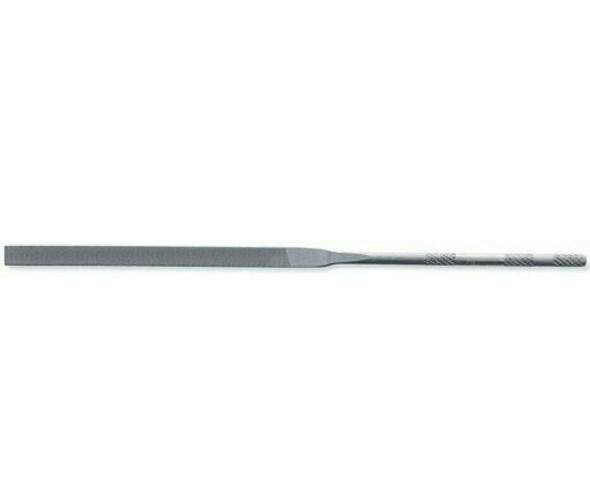Description
• Tough chrome/tool steel alloy construction.
• Precise machining that yields sharp corners and fine points.
• Deep-cut teeth that assure efficient, uniform stock removal.
• 66-67 HRC hardness for exceptional service with minimal care.
• More increments for more precise cutting.
• German cut is a more extreme angle for smoother filing action.
• Teeth on both sides.
• Tapered file with one flat and one domed side for filing both flat and curved surfaces.
• Available in a set of six. Also available in a set of 12.
Shape: Half-round
Type: Needle
Overall length: 6-1/4" (160mm)
Cutting surface dimensions: 3 -1/8"L x 1/4"W (80 x 5.6mm)
Brand: Friedrich Dick
German cut no.: 2
Swiss cut no.: 1
Country of origin: Switzerland
Shipping weight: 0.514 ounces (14.585g)
How To Choose the Right File
Understanding how to choose the appropriate file sizes, shapes and styles for the work you do will help ensure high-quality, repeatable results for all your jewelry designs.
A file is a metalworking tool used to cut fine amounts of material from a workpiece. The most common file is a hand tool--a hardened steel bar with a series of sharp, parallel ridges, called teeth.
Choose a file shape that is as close a match as possible to the contour of the piece you're filing.
Files have forward-facing cutting teeth, and cut most effectively when pushed 'straight ahead' over the workpiece. 'Draw-filing' involves laying the file sideways on the work, and carefully pushing or pulling it across the work. This catches the teeth of the file sideways instead of head on, and a very fine shaving action is produced. There are also varying strokes that produce a combination of the straight-ahead stroke and the draw-filing stroke, and very fine work can be achieved in this fashion. Using a combination of strokes, and progressively finer files, a skilled operator can attain a surface that is perfectly flat with a nearly mirror-finish.
To prevent the teeth from becoming clogged as you work, tap the end of the file lightly on the bench after several strokes to dislodge chips of material from the teeth. Clean files occasionally with a file brush. To clean, hold the file at the tang end with the point of the tang resting on the work surface and rub the brush diagonally across the file.
The cut of the file refers to how fine its teeth are. They are defined from roughest to smoothest.
A single-cut file has one set of parallel teeth while a cross-cut or double-cut file has a second set of teeth.
• FILE CUTS
Files are graded by numbers ranging from 00 (the coarsest) to 6 (the finest).
CUT # TEETH/INCH
00 38
0 51
1 64
2 79
3 97
4 117
6 173
• HAND FILES
Hand files are approximately 8" long and 5/8" wide. These files are most often sold individually but are also available in sets that contain the most popular styles. Hand files are used for a broad range of applications that require the removal of material from the workpiece for shaping, smoothing or finishing. Most files have a narrow, tapered tang at one end to which a handle can be fitted. The tang can also be used to secure the file in a vise for hands-free use.
• NEEDLE FILES
Needle files are approximately 4" long and 3/16" wide. Needle files are usually sold in sets of 6 or 12 (or more) different shapes,







